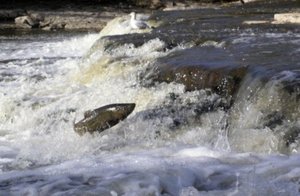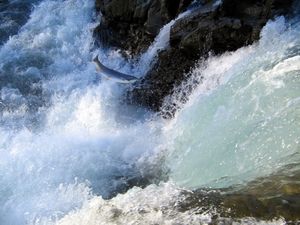Anadromous behavior

Anadromy is when a fish that spends much of its life cycle in the ocean migrates up into freshwater in order to reproduce. The young fish, in turn, migrate back down into sea water. Major examples of anadromous fish include several species of salmon, as well as the striped bass. Some other species (e.g., alewife, white perch) undergo less extensive migrations from the ocean into estuaries or from estuaries into freshwater in order to spawn. Many of these species support important commercial and/or recreational fisheries (Fisheries and aquaculture).
The most well-known example of anadromy is seen among the salmon. Salmon are capable of traveling hundreds of kilometers upriver. The Pacific salmon species - Chinook (King), Coho (Silver), Sockeye (Red), Chum (Dog) and Pink (Humpback) - generally die after breeding, thus providing substantial nutrition to the residents in the small streams where they lay their eggs. These streams are generally fairly low in nutrients, so this is quite a major windfall. Bears also take advantage of this protein input. In contrast, Atlantic salmon can survive and return to the ocean. A particularly interesting aspect of salmon migration is that individual fish return to the same stream where they hatched years earlier. Scientists have discovered that the fish find their way back home through their sense of smell, or olfaction. It is amazing to think that, in the vastness of the ocean, there are enough molecules of “home” odor to allow a salmon to determine which river to turn up and which fork to take during their upstream migration! After the eggs hatch, the young salmon live in the streams for a period of time and then migrate back down to the ocean after they have reached a certain stage of development.
Salmon are in decline for a number of reasons, one major one being the construction of dams in the waterways they use for migration. These dams block the migration routes and prevent them from reaching the upstream breeding sites. Similarly, dams can be lethal to young salmon migrating down the rivers. People have constructed “fish ladders” (much like a staircase for fish!) to help the fish up or down in small stages in order to cross the dams. These structures enable some percentage, although not all, of the fish to migrate successfully. Other reasons for the decline of salmon are related to overfishing and water and habitat quality.
